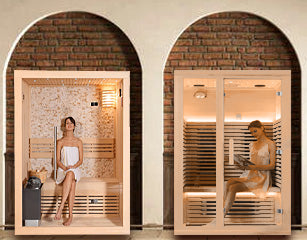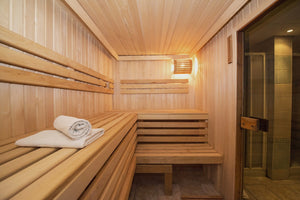When it comes to bringing the relaxation and wellness benefits of a sauna into your home, you're faced with a choice: infrared or traditional. Both types of saunas offer unique experiences and health advantages. In this blog post, we'll explore the key differences and factors to consider when choosing the right sauna for your home: Infrared vs. Traditional.
Infrared Saunas:
Infrared saunas use infrared heaters to emit radiant heat that is absorbed directly by your body. They are gaining popularity for several reasons:
1. Penetrating Heat:
- Infrared saunas heat your body directly, which is believed to penetrate deeper into your muscles and tissues. This can lead to a more profound sense of relaxation and pain relief.
2. Lower Temperature:
- Infrared saunas operate at a lower temperature (typically between 120°F and 150°F), making them more comfortable for people who can't tolerate the intense heat of traditional saunas.
3. Detoxification:
- Infrared saunas can promote detoxification by increasing sweat production, helping to eliminate toxins and heavy metals from your body.
4. Energy Efficiency:
- Infrared saunas are often more energy-efficient and cost-effective to operate compared to traditional saunas, making them a practical choice for many homeowners.
Traditional Saunas:
Traditional saunas, also known as Finnish saunas, use heated rocks or a stove to warm the air inside a small, insulated room. Here are some key aspects of traditional saunas:
1. High Temperatures:
- Traditional saunas are known for their high temperatures, typically ranging from 150°F to 195°F. This intense heat can lead to profuse sweating and a more traditional sauna experience.
2. Steam and Humidity:
- Water is poured onto the heated rocks, creating steam and increasing humidity levels. This can enhance the sauna experience for those who enjoy a steamy environment.
3. Social and Cultural Tradition:
- Traditional saunas have a long history and cultural significance in many regions, such as Finland. They are often considered a communal and social experience.
4. Quick Heating:
- Traditional saunas heat up quickly, allowing you to start your sauna session almost immediately.
Choosing the Right Sauna for Your Home: Considerations
-
Health Goals:
- Consider your wellness objectives. If you're looking for pain relief, detoxification, or relaxation, infrared saunas may be a better fit. Traditional saunas, with their high heat and humidity, may be preferable if you enjoy the more traditional sauna experience.
-
Space and Installation:
- Think about the available space in your home. Infrared saunas are often smaller and easier to install, making them suitable for tight spaces. Traditional saunas require more room and specific construction.
-
Budget and Operating Costs:
- Consider your budget for purchase and operating costs. Infrared saunas tend to be more cost-effective to run, while traditional saunas may require a larger upfront investment.
-
Personal Preferences:
- Your personal preferences matter. Some individuals prefer the intense, dry heat of traditional saunas, while others favor the gentle, penetrating warmth of infrared saunas.
Conclusion
Choosing the right sauna for your home ultimately depends on your health goals, available space, budget, and personal preferences. Both infrared and traditional saunas offer unique benefits, and the ideal choice will be the one that aligns best with your needs. Whichever type you choose, having a sauna at home can be a wonderful addition to your wellness routine, offering relaxation, stress relief, and various health benefits.
 Log in
Log in



